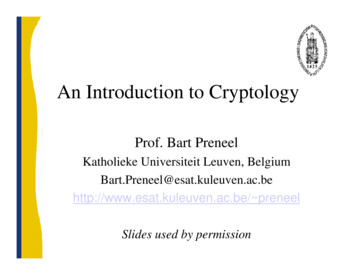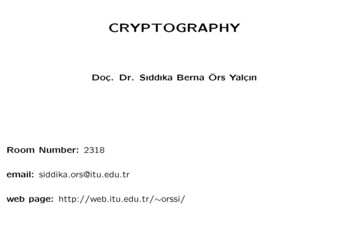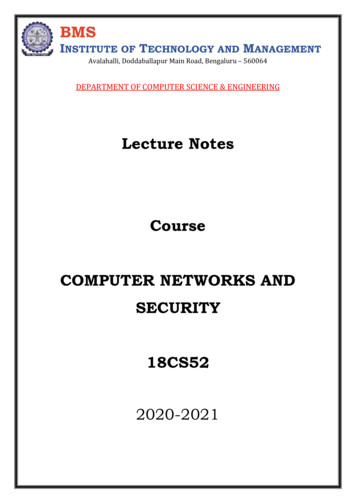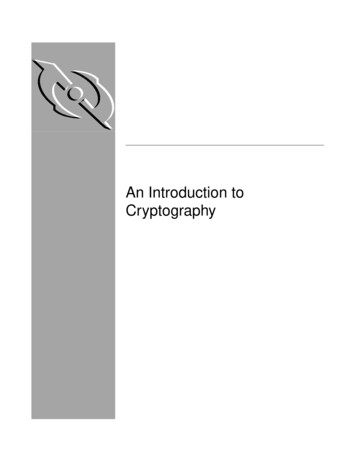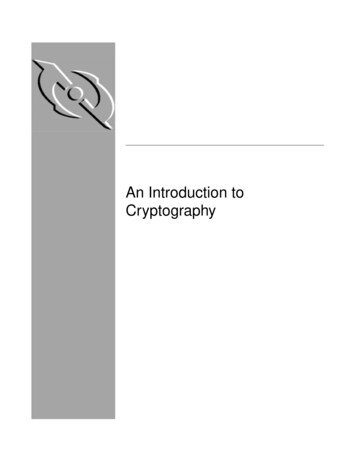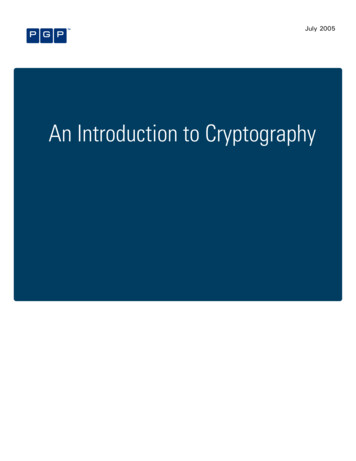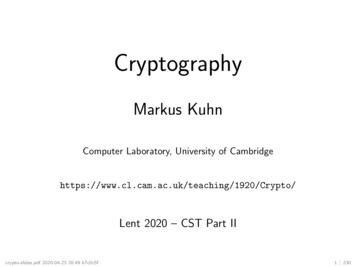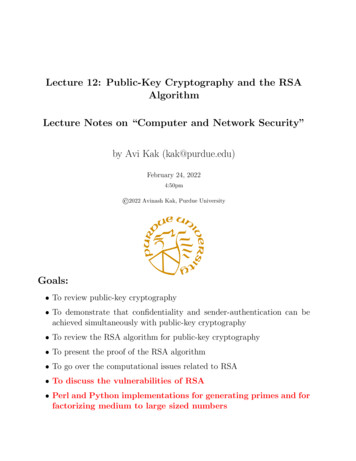
Transcription
Lecture 12: Public-Key Cryptography and the RSAAlgorithmLecture Notes on “Computer and Network Security”by Avi Kak (kak@purdue.edu)February 24, 20224:50pm 2022 Avinash Kak, Purdue UniversityGoals: To review public-key cryptography To demonstrate that confidentiality and sender-authentication can beachieved simultaneously with public-key cryptography To review the RSA algorithm for public-key cryptography To present the proof of the RSA algorithm To go over the computational issues related to RSA To discuss the vulnerabilities of RSA Perl and Python implementations for generating primes and forfactorizing medium to large sized numbers
CONTENTSSection TitlePage12.1Public-Key Cryptography312.2The Rivest-Shamir-Adleman (RSA) Algorithm forPublic-Key Cryptography — The Basic Idea812.2.1The RSA Algorithm — Putting to Use the Basic Idea1212.2.2How to Choose the Modulus for the RSA Algorithm1412.2.3Proof of the RSA Algorithm1712.3Computational Steps for Key Generation in RSA2112.3.1Computational Steps for Selecting the Primes p and q2212.3.2Choosing a Value for the Public Exponent e2412.3.3Calculating the Private Exponent d2712.4A Toy Example That Illustrates How to Set n, e, and dfor a Block Cipher Application of RSA2912.5Modular Exponentiation for Encryption and Decryption3512.5.1An Algorithm for Modular Exponentiation3912.6The Security of RSA — Vulnerabilities Caused by Lackof Forward Secrecy4412.7The Security of RSA — Chosen Ciphertext Attacks4712.8The Security of RSA — Vulnerabilities Caused by LowEntropy Random Numbers5312.9The Security of RSA — The Mathematical Attack5712.10Factorization of Large Numbers: The Old RSAFactoring Challenge7712.10.1The Old RSA Factoring Challenge: Numbers Not Yet Factored8112.11The RSA Algorithm: Some Operational Details8312.12RSA: In Summary .9412.13Homework Problems962
Computer and Network Security by Avi KakLecture 12Back to TOC12.1 PUBLIC-KEY CRYPTOGRAPHY Public-key cryptography is also known as asymmetric-keycryptography, to distinguish it from the symmetric-keycryptography we have studied thus far. Encryption and decryption are carried out using twodifferent keys. The two keys in such a key pair are referredto as the public key and the private key. With public key cryptography, all parties interested in securecommunications publish their public keys. [As to how that is done dependson the protocol. In the SSH protocol, each server makes available through its port 22 the public keyit has stored for your login id on the server.(See Section 12.10 for how an SSHD server acquires thepublic key that the server would associate with your login ID so that you can make a password-freeconnection with the server. In the context of the security made possible by the SSH protocol, thepublic key held by a server is commonly referred to as the server’s host key.)When a client, such asyour laptop, wants to make a connection with an SSHD server, it sends a connection request to port22 of the server machine and the server makes its host key available automatically. On the otherhand, in the SSL/TLS protocol, an HTTPS web server makes its public key available through a] As we will see, this solvesone of the most vexing problems associated with symmetric-keycryptography — the problem of key distribution.certificate of the sort you’ll see in the next lecture.3
Computer and Network Security by Avi KakLecture 12 Party A, if wanting to communicate confidentially withparty B, can encrypt a message using B’s publicly availablekey. Such a communication would only be decipherable by B asonly B would have access to the corresponding private key.This is illustrated by the top communication link in Figure 1. Party A, if wanting to send an authenticated message toparty B, would encrypt the message with A’s own private key.Since this message would only be decipherable with A’s publickey, that would establish the authenticity of the message —meaning that A was indeed the source of the message. This isillustrated by the middle communication link in Figure 1. The communication link at the bottom of Figure 1 shows howpublic-key encryption can be used to provide bothconfidentiality and authentication at the same time.Note again that confidentiality means that we want toprotect a message from eavesdroppers and authenticationmeans that the recipient needs a guarantee as to the identity ofthe sender. In Figure 1, A’s public and private keys are designated P UAand P RA. B’s public and private keys are designated P UB andP RB . As shown at the bottom of Figure 1, let’s say that A wants to4
Computer and Network Security by Avi KakLecture 12Party A wants to send a message to Party BWhen only confidentiality is needed:Party BA’s private keyA’s public keyPRAPUAB’s public keyPUBEncrypt with PU BB’s private keyPRBDecrypt with PRBMessageMessageParty AWhen only authentication is needed:Party BA’s private keyA’s public keyPR APUAB’s public keyPUBEncrypt with PR AB’s private keyPR BDecrypt with PUAMessageMessageParty AWhen both confidentiality and authentication are needed:Encryptwith PRAParty BA’s private keyA’s public keyPRAPUAB’s public keyPUBB’s private keyPRBDecryptwith PRBEncryptwith PUBDecryptwith PUAMessageMessageParty AFigure 1: This figure shows how public-key cryptographycan be used for confidentiality, for digital signatures, andfor both. (This figure is from Lecture 12 of “Computer and Network Security” by Avi Kak.)5
Computer and Network Security by Avi KakLecture 12send a message M to B with both authentication andconfidentiality. The processing steps undertaken by A to convertM into its encrypted form C that can be placed on the wire are:C E (P UB , E (P RA, M ))where E() stands for encryption. The processing stepsundertaken by B to recover M from C areM D (P UA, D (P RB , C))where D() stands for decryption. The sender A encrypting his/her message with its own privatekey P RA provides authentication. This step constitutes Aputting his/her digital signature on the message. Instead ofapplying the private key to the entire message, a sender may also “sign” a message byapplying his/her private key to just a small block of data that is derived from themessage to be sent.[DID YOU KNOW that you are required to digitally sign the software for yourapp before you can market it through the official Android application store Google Play? And did you know]that Apple’s App Store has the same requirement? The sender A further encrypting his/her message with thereceiver’s public key P UB provides confidentiality.6
Computer and Network Security by Avi KakLecture 12 Of course, the price paid for achieving confidentiality andauthentication at the same time is that now the message mustbe processed four times in all for encryption/decryption. Themessage goes through two encryptions at the sender’s place andtwo decryptions at the receiver’s place. Each of these four stepsinvolves separately the computationally complexpublic-key algorithm. IMPORTANT: Note that public-key cryptography does notmake obsolete the more traditional symmetric-keycryptography. Because of the greater computational overheadassociated with public-key crypto systems, symmetric-keysystems continue to be widely used for content encryption.However, public-key encryption has proved indispensable for keymanagement, for distributing the keys needed for the moretraditional symmetric key encryption/decryption of the content,for digital signature applications, etc.7
Computer and Network Security by Avi KakLecture 12Back to TOC12.2: THE RIVEST-SHAMIR-ADLEMAN(RSA) ALGORITHM FOR PUBLIC-KEYCRYPTOGRAPHY — THE BASIC IDEA The RSA algorithm is named after Ron Rivest, Adi Shamir,and Leonard Adleman. The public-key cryptography that wasmade possible by this algorithm was foundational to thee-commerce revolution that followed. The starting point for learning the RSA algorithm is Euler’sTheorem that was presented in Section 11.4 of Lecture 11. Torecap, that theorem states that for every positive integer n andevery a that is coprime to n, the following must be trueaφ(n) 1 (mod n)where, as defined in Section 11.3 of Lecture 11, φ(n) is thetotient of n. An immediate consequence of this theorem is that, when aand n are relatively prime, the exponents will behave modulothe totient φ(n) in exponentiated forms like ak mod n.8
Computer and Network Security by Avi KakLecture 12 That is, if a and n are relatively prime, the following must betrue for some k1 and k2:ak ak1·φ(n) k2 ak1 ·φ(n)ak2 ak2(mod n) For example, consider a 4 in arithmetic modulo 15. Thetotient of 15 is 8. (Since 15 3 5, we haveφ(15) 2 4 8.) You can easily verify the following:47 · 44 mod 15 4(7 4) mod 8 mod 15 43 mod 15 64 mod 15 4(43)5 mod 15 4(3 5) mod 8 mod 15 47 mod 15 4Note that in both cases the base of the exponent, 4, is coprimeto the modulus 15. The relationship shown above has some incredibleramifications that point to practical possibilities: To see what Imean, say that M is an integer that represents a message (notethat any bit string in the memory of a computer representssome integer, no matter how large). Let’s now conjure up twointegers e and d that are each other’s multiplicative inversesmodulo the totient φ(n). Assume again that M is coprime tothe modulus n. Since the exponents of M are going to behavemodulo the totient φ(n), the following must be true9
Computer and Network Security by Avi KakLecture 12M e d M e d(mod φ(n)) M (mod n) The result shown above, which follows directly from Euler’stheorem, requires that M and n be coprime. However, as willbe shown in Section 12.2.3, when n is a product of two primesp and q, this result applies to all M, 0 M n. In whatfollows, let’s now see how this idea can be used for messageencryption and decryption. Considering arithmetic modulo n, let’s say that e is an integerthat is coprime to the totient φ(n) of n. Further, say that d isthe multiplicative inverse of e modulo φ(n). These definitions ofthe various symbols are listed below for convenience:n a modulus f or modular arithmeticφ(n) the totient of ne an integer that is relatively prime to φ(n)[T his guarantees that e will possess amultiplicative inverse modulo φ(n)]d an integer that is the multiplicative10
Computer and Network Security by Avi KakLecture 12inverse of e modulo φ(n) Now suppose we are given an integer M , 0 M n, thatrepresents our message, then we can transform M into anotherinteger C that will represent our ciphertext by the followingmodulo exponentiation:CM e mod n We can recover back M from C by the following modulooperationMC d mod n since(M e)d (mod n) M ed(mod φ(n))11 M(mod n)
Computer and Network Security by Avi KakLecture 12Back to TOC12.2.1 The RSA Algorithm — Putting toUse the Basic Idea The basic idea described in the previous subsection can be usedto create a confidential communication channel in the mannerdescribed here. An individual A who wishes to receive messages confidentiallywill use the pair of integers {e, n} as his/her public key. At thesame time, this individual can use the pair of integers {d, n} asthe private key. The definitions of n, e, and d are as in theprevious subsection. Another party B wishing to send a message M to Aconfidentially will encrypt M using A’s public key {e, n} tocreate ciphertext C. Subsequently, only A will be able todecrypt C using his/her private key {d, n}. If the plaintext message M is too long, B may choose to useRSA as a block cipher for encrypting the message meant forA. As explained by my toy example in Section 12.4, when RSAis used as a block cipher, the block size is likely to be half thenumber of bits required to represent the modulus n. If the12
Computer and Network Security by Avi KakLecture 12modulus required, say, 1024 bits for its representation, messageencryption would be based on 512-bit blocks. [While, in principle,RSA can certainly be used as a block cipher, in practice, on account of its excessivecomputational overhead, it is more likely to be used just for server authentication andfor exchanging a secret session key. A session key generated with the help ofRSA-based encryption can subsequently be used for content encryption usingsymmetric-key cryptography based on, say, AES.] The important theoretical question here is as to what conditionsif any must be satisfied by the modulus n for thisM C M transformation to work?13
Computer and Network Security by Avi KakLecture 12Back to TOC12.2.2 How to Choose the Modulus for theRSA Algorithm With the definitions of d and e as presented in Section 12.2, themodulus n must be selected in such a manner that the followingis guaranteed: e dM ) M ed M(mod n)We want this guarantee because C M e mod m is theencrypted form of the message integer M and decryption iscarried out by C d mod n. While the above property is always true as long as M and n arerelatively prime, it was shown by Rivest, Shamir, and Adlemanthat the above property holds for all M if n is a product oftwo prime numbers:n p qf or some prime p and prime q The above factorization is needed because the proof of thealgorithm, presented in the next subsection, depends on thefollowing two properties of primes and coprimes:14(1)
Computer and Network Security by Avi KakLecture 121. If two integers p and q are coprimes (meaning, relativelyprime to each other), the following equivalence holds for anytwo integers a and b:{a b (mod p) and a b (mod q)} {a b (mod pq)}(2)This equivalence follows from the fact a b(mod p) implies a b k1p for some integer k1. Butsince we also have a b (mod q) implying a b k2q,it must be the case that k1 k3 q for some k3.Therefore, we can write a b k3 p q, whichestablishes the equivalence. (Note that this argument breaksdown if p and q have common factors other than 1.) [We willuse this property to arrive at Equation (11) shown in the next subsection from thepartial results in Equations (9) and (10) presented in the same subsection.]2. In addition to needing p and q to be coprimes, we alsowant p and q to be individually primes. It is onlywhen p and q are individually prime that we can decomposethe totient of n into the product of the totients of p and q.That isφ(n) φ(p) φ(q) (p 1) (q 1)(3)See Section 11.3 of Lecture 11 for a proof of this. [We will usethis property to go from Equation (5) to Equation (6) in the next subsection.]15
Computer and Network Security by Avi KakLecture 12 So that the cipher cannot be broken by an exhaustive search forthe prime factors of the modulus n, it is important that both pand q be very large primes. Finding the prime factors ofa large integer is computationally harder thandetermining its primality. We also need to ensure that n is not factorizable by one of themodern integer factorization algorithms. More on that later inthese notes.16
Computer and Network Security by Avi KakLecture 12Back to TOC12.2.3: Proof of the RSA Algorithm We already know through Euler’s theorem that when themodulus n and the message integer M are coprimes, then, inarithmetic modulo n, the exponents behave modulo the totientof n. Now we want to prove that when the modulus n is a product oftwo primes p and q, it is always the case for all integers0 M n that M e d M (mod n) where e and d are eachother’s MIs modulo φ(n). [The specific derivational steps presented belowdo not impose the constraint that the message integer M be limited to 0 M n.However, should it be the case that M n, what would be returned by the operationM e d mod n would be the remainder of M in Zn . Let’s just say that the messageinteger is given by M n. For this value of M, the value returned byM e d mod n would be 0, which is not a very useful thing to happen.] Using the definitions of d and e as presented in Section 12.2,since the integer d is the multiplicative inverse of the integer emodulo the totient φ(n), we obviously havee d 1(mod φ(n))This implies that there must exist an integer k so that17(4)
Computer and Network Security by Avi KakLecture 12e d 1 0 (mod φ(n)) k φ(n)(5) It must then obviously be the case that φ(n) is a divisor of theexpression e d 1. But since φ(n) φ(p) φ(q), thetotients φ(p) and φ(q) must also individually be divisors ofe d 1. That isφ(p) (e d 1)andφ(q) (e d 1)(6)The notation ‘ ’ to indicate that its left argument is a divisor ofthe right argument was first introduced at the end of Section 5.1in Lecture 5. Focusing on the first of these assertions, since φ(p) is a divisorof e d 1, we can writee d 1 k1φ(p)for some integer k1.18 k1(p 1)(7)
Computer and Network Security by Avi KakLecture 12 Therefore, we can write for any integer M :M e d mod p M e d 1 1mod p M k1(p 1) M mod p(8) Now we have two possibilities to consider: Since p is a prime, itmust be the case that either M and p are coprimes or that M isa multiple of p.– Let’s first consider the case when M and p are coprimes. ByFermat’s Little Theorem (presented in Section 11.2 ofLecture 11), since p is a prime, we haveMp 1 1 (mod p)Since this conclusion obviously extends to any power of theleft hand side, we can writeM k1(p 1) 1 (mod p)Substituting this result in Equation (8), we getM e d mod p19 M mod p(9)
Computer and Network Security by Avi KakLecture 12– Now let’s consider the case when the integer M is a multipleof the prime p. Now obviously, M mod p 0. This willalso be true for M raised to any power. That is,M k mod p 0 for any integer k. Therefore, Equation (9)will continue to be true even in this case. From the second assertion in Equation (6), we can draw anidentical conclusion regarding the other factor q of the modulusn:M e d mod q M mod q(10) We established in Section 12.2.2 that, when p and q arecoprimes, for any integers a and b if we have a b(mod p) and a b (mod q), then it must also be the casethat a b (mod pq). Applying this conclusion to the partialresults shown in Equations (9) and (10), we getM e d mod n20 M mod n(11)
Computer and Network Security by Avi KakLecture 12Back to TOC12.3 COMPUTATIONAL STEPS FOR KEYGENERATION IN RSA CRYPTOGRAPHY The computational steps for key generation are1. Generate two different primes p and q2. Calculate the modulus n p q3. Calculate the totient φ(n) (p 1) (q 1)4. Select for public exponent an integer e such that1 e φ(n) and gcd(φ(n), e) 15. Calculate for the private exponent a value for d such thatd e 1 mod φ(n)6. P ublic Key [e, n]7. P rivate Key [d, n] The next three subsections elaborate on these computationalsteps.21
Computer and Network Security by Avi KakLecture 12Back to TOC12.3.1 Computational Steps for Selecting thePrimes p and q in RSA Cryptography You first decide what size (in terms of the number of bits) youwant for the modulus integer n. Let’s say that yourimplementation of RSA requires a modulus of size B bits. To generate the prime integer p;– Using a high-quality random number generator (See Lecture10 on random number generation), you first generate arandom number of size B/2 bits.– You set the lowest bit of the integer generated by the abovestep; this ensures that the number will be odd.– You also set the two highest bits of the integer; thisensures that the highest bits of n will be set. (See Section12.4 for an explanation of why you need to set the first twobits.)– Using the Miller-Rabin algorithm described in Lecture 11,you now check to see if the resulting integer is prime. If not,you increment the integer by 2 and check again. This22
Computer and Network Security by Avi KakLecture 12becomes the value of p. You do the same thing for selecting q. You start with arandomly generated number of size B/2 bits, and so on. In the unlikely event that p q, you throw away your randomnumber generator and acquire a new one. For greater security, instead of incrementing by 2 when theMiller-Rabin test fails, you generate a new random number.23
Computer and Network Security by Avi KakLecture 12Back to TOC12.3.2 Choosing a Value for the PublicExponent e Recall that encryption consists of raising the message integer Mto the power of the public exponent e modulo n. This step isreferred to as modular exponentiation. The mathematical requirement on e is that gcd(e, φ(n)) 1,since otherwise e will not have a multiplicative inverse modφ(n). Since n p q, this requirement is equivalent to thetwo requirements gcd(e, φ(p)) 1 and gcd(e, φ(q)) 1. Inother words, we want gcd(e, p 1) 1 andgcd(e, q 1) 1. For computational ease, one typically chooses a value for e thatis prime, has as few bits as possible equal to 1 for fastmultiplication, and, at the same time, that is cryptographicallysecure in the sense described in the next bullet. Typical valuesfor e are 3, 17, and 65537 ( 216 1). Each of these values hasonly two bits set, which makes for fast modularexponentiation. But don’t forget the basic requirement on ethat it must be relatively prime to p 1 and q 1simultaneously. Whereas p is prime, p 1 definitely is not sinceit is even. The same goes for q 1. So even if you wanted to,24
Computer and Network Security by Avi KakLecture 12you may not be able to use a small integer like 3 for e. Small values for e, such as 3, are considered cryptographicallyinsecure. Let’s say a sender A sends the same message M tothree different receivers using their respective public keys thathave the same e 3 but different values of n. Let these valuesof n be denoted n1, n2, and n3. Let’s assume that an attackercan intercept all three transmissions. The attacker will see threeciphertext messages: C1 M 3 mod n1, C2 M 3 mod n2,and C3 M 3 mod n3. Assuming that n1, n2, and n3 arerelatively prime on a pairwise basis, the attacker can use theChinese Remainder Theorem (CRT) of Section 11.7 of Lecture11 to reconstruct M 3 modulo N n1 n2 n3. (This assumes thatM n n n , which is bound to be true since M n , M n , and M n .) Havingreconstructed M 3, all that the attacker has to do is to figure outthe cube-root of M 3 to recover M . Finding cube-roots of evenlarge integers is not that hard. (The Homework Problems section includes aprogramming assignment that focuses on this issue.)3123123 Having selected a value for e, it is best to double check thatwe indeed have gcd(e, p 1) 1 and gcd(e, q 1) 1(since we want e to be coprime to φ(n), meaning that we wante to be coprime to p 1 and q 1 separately). Note that evenif we chose a prime for e, that would NOT mean that such ane would necessarily be coprime to p 1 and q 1. Consider, forexample, e 3 and for p and q let us say we have the primesp 1297 and q 1301. In this case, p 1 1296 and25
Computer and Network Security by Avi KakLecture 12q 1 1300. Obviously, e 3 is NOT coprime to p 1.Therefore, this e will not be coprime to the totient of themodulus n p q, implying that for these e and n there willNOT exist the private exponent d. If either p or q is found to not meet the above mentionedconditions on the relative primality of φ(p) and φ(q) vis-a-vis e,you must discard the calculated p and/or q and start over. (It isfaster to build this test into the selection algorithm for p and q.)When e is a prime and greater then 2, a much faster way tosatisfy the two conditions is to ensurep mod eq mod e6 6 11 To summarize the point made above, you give priority tousing a particular value for e – such as a value like65537 that has only two bits set. Having made a choice for theencryption integer e, you now find the primes p and q that,besides satisfying all other requirements on these two numbers,also satisfy the conditions that the chosen e would be coprimeto the totients φ(p) and φ(q).26
Computer and Network Security by Avi KakLecture 12Back to TOC12.3.3: Calculating the Private Exponent d Once we have settled on a value for the public exponent e, thenext step is to calculate the private exponent d from e and themodulus n. Recall that d e 1 (mod φ(n)).d We can also write this ase 1 mod φ(n)Calculating ‘e 1 mod φ(n)’ is referred to as modularinversion. Since d is the multiplicative inverse of e modulo φ(n), we canuse the Extended Euclid’s Algorithm (see Section 5.6 of Lecture5) for calculating d. Recall that we know the value forφ(n) since it is equal to (p 1) (q 1). Note that the main source of security in RSA iskeeping p and q secret and therefore also keepingφ(n) secret. It is important to realize that knowing either willreveal the other. That is, if you know the factors p and q, you27
Computer and Network Security by Avi KakLecture 12can calculate φ(n) by multiplying p 1 with q 1. And if youknow φ(n) and n, you can calculate the factors p and q readily. Here is another reason for why it is critical to keep φ(n) secret:Assuming otherwise, your adversary would obviously know yourpublic exponent e from your public key. It would be trivial forthe adversary to use the Extended Euclid’s Algorithm to figureout your private exponent d by finding the multiplicative inverseof e modulo φ(n).28
Computer and Network Security by Avi KakLecture 12Back to TOC12.4 A TOY EXAMPLE THATILLUSTRATES HOW TO SET n, e, d FOR ABLOCK CIPHER APPLICATION OF RSA As alluded to briefly at the end of Section 12.2.1, you areunlikely to use RSA as a block cipher for general contentencryption. As mentioned in Section 12.12, for the modulineeded in today’s computing environments, the computationaloverhead associated with RSA is much too high for it to besuitable for content encryption. Nevertheless, RSA (along withECC to be presented in Lecture 14) plays a critical role inpractically all modern protocols for establishing securecommunication links between clients and servers. Theseprotocols depend on RSA (and ECC) for clients and servers toauthenticate each other — as you’ll see in Lecture 13. Inaddition, RSA may also be used for generating session keys.Despite the fact that you are not likely to use RSA for contentencryption, it’s nonetheless educational to reflect on how itcould be used for that purpose in the form of a block cipher. For the sake of illustrating how you’d use RSA as a block cipher,let’s try to design a 16-bit RSA cipher for block encryption ofdisk files. A 16-bit RSA cipher means that our modulus willspan 16 bits. [Again, in the context of RSA, an N-bit cipher means that the29
Computer and Network Security by Avi KakLecture 12modulus is of size N bits and NOT that the block size is N bits. This is contrary tonot-so-uncommon usage of the phrase “N-bit block cipher” meaning a cipher thatencrypts N-bit blocks at a time as a plaintext source is scanned for encryption.] With the modulus size set to 16 bits, we are faced with theimportant question of what to use for the size of bit blocks forconversion into ciphertext as we scan a disk file. Since ourmessage integer M must be smaller than the modulus n,obviously our block size cannot equal the modulus size. Thisrequires that we use a smaller block size, say 8 bits, and, asmentioned in the next bullet, use padding to fill the rest of the16 bits. As it turns out, padding is an extremely important partof RSA ciphers. In addition to the need for padding asexplained here, padding is also needed to make the cipherresistant to certain vulnerabilities that are described in Section12.7 of this lecture. In the rest of the discussion in this section, I’ll assume thatwhereas the modulus n will span 16 bits for the toy example,the block size will be smaller than 16 bits, say, only 8 bits. I’llfurther assume that, as a disk file is scanned 8 bits at a time,each such bit block is padded on the left with zeros to make it16 bits wide. I’ll refer to this padded bit block as our messageinteger M . So my first job is to find a modulus n whose size is 16 bits.30
Computer and Network Security by Avi KakLecture 12Recall that n must be a product of two primes p and q.Assuming that we want these two primes to be roughly thesame size, let’s allocate 8 bits to p and 8 bits to q. So the issue now is how to find a prime suitable for our 8-bitrepresentation. Following the prescription given in Section12.3.1, we could fire up a random number generator, set its firsttwo bits and the last bit, and then test the resulting number forits primality with the Miller-Rabin algorithm presented inLecture 11. But we don’t need to go to all that trouble for ourtoy example. Let’s use the simpler approach described below. Let’s assume that we have an as yet imaginary 8-bit word for pwhose first two and the last bit are set. And assume that thesame is true for q. So both p and q have the following bitpatterns:bits of pbits of q11 111 1::where ’ ’ denotes the bit that has yet to be determined. As youcan verify quickly from the three bits that are set, such an 8-bitinteger will have a minimum decimal value of 193. [Here is areason for why you need to manually set the first two bits: Assume for a moment thatyou set only the first bit. Now it is theoretically possible for the smallest values for p31
Computer and Network Security by Avi KakLecture 12and q to be not much greater than 27 . So the product p q could get to be as small as214 , which obviously does not span the full 16 bit range desired for n. When you setthe first two bits, now the smallest values for p and q will be lower-bounded by27 26 . So the product p q will be lower-bounded by 214 2 213 212 , which itselfis lower-bounded by 2 214 215 , which corresponds to the full 16-bit span. Withregard to the setting of the last bit of p and q, that is to ensure that p and q will beodd.] So the question reduces to whether there exist two primes(hopefully different) whose decimal values exceed 193 but areless than 255. If you carry out a Google search with a string lik
PUA PUB PRA PUA PUB PRB PRA PUB PRB PUA PRA PUA PUB PRB Encrypt with PUB Decrypt with PR B Party A wants to send a message to Party B When only confidentiality is needed: When only authentication is needed: When both confidentiality and authentication are needed: A's private key A's public key Message B's public key B's private key Message

